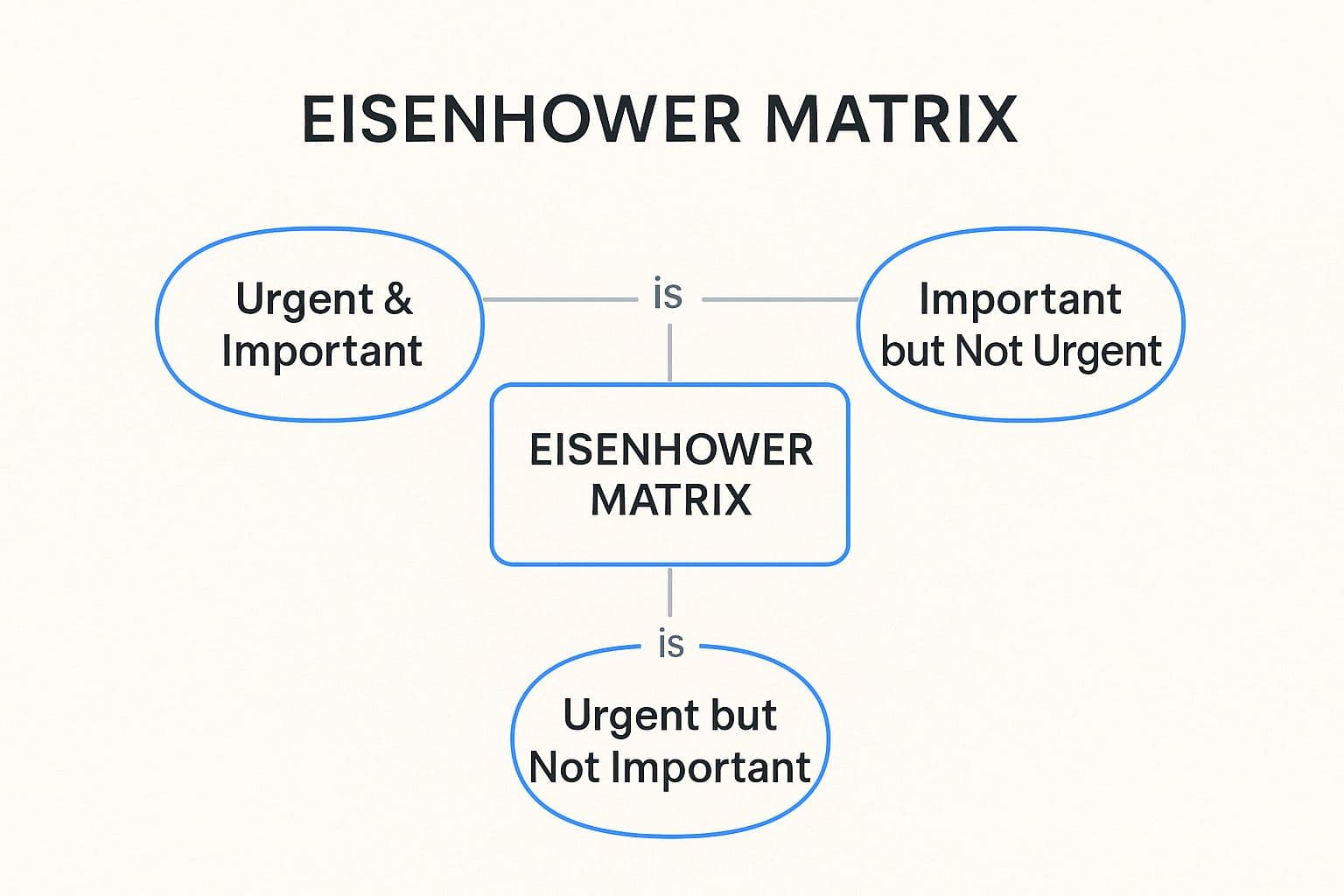9 Proven Ways to Improve Efficiency in Your Workflow (2025)
Tired of repetitive tasks? Learn 9 proven strategies to improve efficiency in your content and writing workflows. Features tips, examples, and tools.

Being busy doesn't always mean being productive. We often get caught in a cycle of repetitive tasks, endless to-do lists, and context switching that drains our energy and stalls our progress. The real goal isn’t just to do more work, but to achieve better results with less effort. So, how do we escape the busy trap and genuinely improve efficiency? It starts with adopting smarter strategies and leveraging the right tools.
This article dives straight into nine powerful, time-tested methods, from classic time management frameworks like GTD to modern digital solutions, that can revolutionize your workflow. Whether you're a writer, marketer, or solopreneur, these actionable insights will help you reclaim your time, reduce friction, and focus on what truly matters.
You'll learn practical ways to implement these strategies immediately. We'll also explore how innovative AI assistants like TypeBoost can supercharge these techniques, embedding directly into your workflow to turn good habits into effortless productivity. Forget app switching and generic advice; it's time to build a system that works for you, wherever you write. Let's get started.
1. Master Your Focus with the Pomodoro Technique
If you constantly find yourself pulled in a million directions or staring down a massive to-do list, the Pomodoro Technique is your secret weapon. This time management method is beautifully simple: you work in focused 25-minute sprints (called "pomodoros") and then take a 5-minute break. After four of these cycles, you reward yourself with a longer 15-30 minute break.
This approach is a game-changer for anyone trying to improve efficiency. It transforms overwhelming projects into a series of manageable, bite-sized tasks. Instead of thinking, "I have to write this whole blog post," you just have to focus for 25 minutes. It’s a powerful psychological trick that helps you get started and stay in the zone.
How to Implement It
Getting started is easy. All you need is a timer. You can use your phone, a dedicated app, or even a simple kitchen timer.
- Step 1: Choose a single task to work on.
- Step 2: Set your timer for 25 minutes and work on that task without any interruptions.
- Step 3: When the timer rings, stop working and take a 5-minute break. Stretch, grab some water, or step away from your screen.
- Step 4: Repeat the cycle. After your fourth pomodoro, take a longer, more restorative break.
For solopreneurs juggling client work and content creation, this method creates a clear structure. For example, dedicate one pomodoro to drafting an email newsletter, the next to brainstorming social media posts, and another to editing a client proposal. This compartmentalization prevents context switching and keeps your mind sharp, dramatically boosting your output and helping you maintain momentum throughout the day.
2. Getting Things Done (GTD)
If your brain feels like an overcrowded browser with too many tabs open, the Getting Things Done (GTD) method is the system reboot you need. Created by David Allen, GTD is a comprehensive framework for capturing, clarifying, and organizing everything on your plate. Its core principle is to move all your tasks, ideas, and commitments out of your head and into a trusted external system, freeing up mental RAM for focused, creative work.

This method is more than just a to-do list; it’s a holistic approach to managing your life's inventory. For anyone aiming to improve efficiency, GTD provides a clear path to gaining control over your commitments. Instead of feeling overwhelmed by a vague sense of "everything I have to do," you'll have a reliable system that tells you exactly what to work on next, depending on your context and energy levels. It’s perfect for clearing the mental clutter that kills productivity.
How to Implement It
Implementing GTD involves five core steps. You can use digital tools like Notion or Trello, or a simple notebook. The key is consistency.
- Step 1: Capture: Write down everything that has your attention into an "inbox." This includes tasks, ideas, reminders, and appointments.
- Step 2: Clarify: Process your inbox one item at a time. For each item, decide if it's actionable. If not, trash it, file it as a reference, or put it on a "someday/maybe" list.
- Step 3: Organize: If an item is actionable, decide the very next physical action. If it takes less than two minutes, do it immediately. Otherwise, delegate it or defer it by putting it on the appropriate list (e.g., @calls, @computer, @errands).
- Step 4: Reflect: Review your lists regularly. A weekly review is crucial to keep the system current, process new inputs, and ensure you’re on track with your larger goals.
For entrepreneurs juggling multiple projects, GTD is a lifesaver. You might have a "Project A" list, a context list for "@client-calls," and another for "@writing-deep-work." This segmentation ensures you can quickly find relevant tasks based on your current situation, preventing procrastination and helping you make significant progress on what truly matters.
3. Adopt a Lean Mindset to Eliminate Waste
While it originated on the factory floors of Toyota, the Lean Methodology is a powerful framework for trimming the fat from any process, including your content creation workflow. Its core idea is simple: relentlessly identify and eliminate "waste" (anything that doesn't add value for the end user) to maximize value and improve efficiency.
This isn't just about working faster; it's about working smarter. By focusing on value-driven activities, you stop wasting precious time and energy on tasks that don't move the needle. For a solopreneur, this could mean cutting out overly complex review cycles or ditching social media platforms that yield zero engagement. It's about creating a streamlined system where every action has a purpose.
How to Implement It
Adopting a Lean mindset starts with mapping out your current processes to spot the bottlenecks and unnecessary steps. The goal is continuous, incremental improvement, not a massive, one-time overhaul.
- Step 1: Map your value stream. Whiteboard your entire process, from idea generation to publishing and promotion.
- Step 2: Identify the "waste." Look for delays, rework, unnecessary features, or complex handoffs. Are you spending hours formatting a report nobody reads? That's waste.
- Step 3: Focus on one area of waste at a time. Pick the biggest bottleneck and brainstorm ways to simplify or eliminate it.
- Step 4: Implement the change and measure the impact. Did it save time? Did it improve quality?
- Step 5: Repeat the cycle. Continuous improvement is the heart of Lean.
For content creators, this is revolutionary. Instead of writing, editing, and designing a blog post in separate, clunky stages, you can create a flow. For instance, you could use a single document for your draft, notes, and final edits, eliminating the waste of switching between apps. By constantly asking, "Does this step add real value?" you ensure your efforts are always focused on what truly matters.
4. Automate Repetitive Tasks with Digital Tools
If you feel like you're constantly bogged down by the same manual, time-consuming tasks, it's time to embrace automation. The strategic use of digital tools allows you to offload repetitive work to software, freeing up your mental energy for high-impact activities that truly require your expertise and creativity.

This approach is essential for anyone looking to seriously improve efficiency. Instead of manually sending follow-up emails, generating invoices, or posting social media updates, you can build automated workflows that handle these processes for you. It’s like having a digital assistant working 24/7, ensuring consistency and saving you countless hours.
How to Implement It
You don’t need to be a tech genius to start automating. Tools like Zapier or Make allow you to connect your favorite apps with simple "if this, then that" logic.
- Step 1: Identify a high-volume, repetitive task in your workflow. A great starting point is often something you do daily or weekly.
- Step 2: Map out the exact steps of the process from start to finish. This clarity is crucial for successful automation.
- Step 3: Choose tools that integrate well with your existing systems. Start small and build complexity as you get more comfortable.
- Step 4: Monitor your automated workflows to ensure they're running correctly and optimize them over time for even better results.
For a content creator, this could mean automatically adding new newsletter subscribers to a welcome email sequence. For a freelance developer, exploring the Top Invoice Automation Software can streamline your billing cycle, ensuring you get paid faster with less manual effort. By strategically applying automation, you can eliminate tedious work and focus on what matters most. You can learn more about how to automate repetitive tasks on typeboost.ai.
5. Prioritize Like a President with the Eisenhower Matrix
If your to-do list feels more like an endless scroll of demands than a plan for success, the Eisenhower Matrix is the framework you need. Popularized by President Dwight D. Eisenhower and later by Stephen Covey, this decision-making tool helps you sort tasks not just by urgency, but by importance. It forces you to distinguish between what feels urgent and what truly moves the needle.
This method is a lifeline for anyone trying to improve efficiency by cutting through the noise. It helps you categorize every task into one of four quadrants: Do, Decide, Delegate, and Delete. This simple act of sorting provides immense clarity, ensuring your most valuable time and energy are spent on high-impact activities, not just fighting the latest fire.
How to Implement It
Getting started requires a mental shift from "what's next?" to "what matters most?". You can sketch this out on a whiteboard, use a digital tool, or just a piece of paper.
- Step 1: List all your tasks for the day or week.
- Step 2: Draw a four-quadrant grid. Label the Y-axis "Importance" and the X-axis "Urgency."
- Step 3: Place each task into one of the four quadrants:
- Quadrant 1 (Urgent & Important): Do it now. These are crises or tasks with immediate deadlines.
- Quadrant 2 (Important, Not Urgent): Decide when to do it. This is where strategic growth happens: planning, relationship building, and long-term projects.
- Quadrant 3 (Urgent, Not Important): Delegate it. These are interruptions or tasks that don't align with your goals.
- Quadrant 4 (Not Urgent, Not Important): Delete it. These are time-wasters and distractions.
For a freelance marketer, this means tackling a client's urgent ad campaign issue (Q1) before scheduling time for professional development or networking (Q2), while delegating social media scheduling (Q3) and ignoring irrelevant online debates (Q4). It ensures you're working on your business, not just in it.
The following infographic visualizes the core action categories of the Eisenhower Matrix, showing how to handle tasks based on their urgency and importance.
This visualization highlights that the most effective people focus on scheduling important but not urgent tasks, rather than just reacting to what's urgent.

6. Adopt an Agile Methodology
Originating in software development, the Agile methodology is a powerhouse approach for managing complex projects with changing requirements. It's all about breaking big goals into smaller, manageable cycles called "sprints." This iterative process values flexibility, collaboration, and continuous improvement over rigid, long-term planning.
This system is a secret weapon to improve efficiency because it forces you to prioritize and deliver value quickly. Instead of getting bogged down by a massive, year-long content plan, you focus on what you can accomplish in the next two weeks. This creates momentum, allows for rapid feedback, and helps you adapt to new opportunities or audience feedback without derailing your entire strategy.
How to Implement It
You don't need a team of developers to go Agile; solopreneurs and small teams can easily adopt its principles using simple tools like Trello or a physical whiteboard.
- Step 1: Create a "backlog" of all your potential tasks, like blog posts, social media campaigns, or client reports.
- Step 2: Plan a "sprint," typically a 1-2 week period. Pull the highest-priority tasks from your backlog into your sprint plan.
- Step 3: Work on only those tasks during the sprint. Use a Kanban board with columns like "To-Do," "In Progress," and "Done" to visualize your workflow.
- Step 4: At the end of the sprint, hold a "retrospective" to review what went well and what could be improved for the next cycle.
For a content creator, a sprint could involve writing two blog posts, creating a week's worth of social media content, and outlining a new newsletter. This approach provides structure while leaving room for creative flexibility, preventing burnout and ensuring you consistently produce high-impact work. It turns overwhelming projects into a steady, predictable rhythm of accomplishment.
7. Adopt Time Blocking for Unwavering Focus
If a reactive to-do list leaves you feeling scattered and unproductive, time blocking is the proactive solution you need. This scheduling method involves assigning every minute of your workday to a specific task. Instead of just knowing what you need to do, you decide exactly when you’ll do it, creating an intentional, focused schedule.
This approach is essential for anyone who wants to improve efficiency because it eliminates decision fatigue and protects your most important work. You treat appointments with yourself as seriously as meetings with clients, ensuring that deep work, like writing a cornerstone blog post or developing a new strategy, actually gets done. It’s a powerful way to take control of your calendar instead of letting it control you.
How to Implement It
Getting started with time blocking requires a calendar and a commitment to stick to your plan. The key is to be realistic and build in flexibility.
- Step 1: At the end of each day or the start of each week, list your high-priority tasks.
- Step 2: Open your calendar and drag these tasks into specific, dedicated time slots. Start with larger chunks (e.g., "9-11 AM: Write Client Report").
- Step 3: Include blocks for everything, including email, lunch, and buffer time between tasks for transitions. Color-code different activities for a quick visual overview.
- Step 4: Follow your schedule. At the end of the day, review what you accomplished and adjust your blocks for tomorrow as needed.
For a freelance marketer, this could mean blocking 9-11 AM for writing client ad copy, 11-11:30 AM for checking and responding to emails, and 1-3 PM for creating social media content. This structured approach prevents constant multitasking, protects your creative energy, and ensures all areas of your business receive the attention they deserve, making your entire workflow more predictable and productive.
8. Leverage Delegation and Outsourcing
You can't do it all, and trying to is the fastest way to burn out and kill your productivity. The art of delegation and outsourcing is about strategically handing off tasks to others so you can focus on your high-impact, core activities. This isn’t about being lazy; it's about being a smart operator.
This approach is fundamental to anyone looking to scale their efforts and truly improve efficiency. Instead of drowning in administrative tasks like bookkeeping or social media scheduling, you can reclaim your time for strategy, client work, or product development. It’s about trading money for time, which is often the most valuable resource for a growing business or busy professional.
How to Implement It
Effective delegation starts with trust and clear communication. You need to empower others to succeed without micromanaging them.
- Step 1: Identify and document repetitive, time-consuming tasks that don't require your unique expertise. This could be anything from editing podcast audio to managing your email inbox.
- Step 2: Find the right person or service. This might be a virtual assistant for administrative work, a freelance accountant for your finances, or a specialized agency for your marketing.
- Step 3: Provide crystal-clear instructions, goals, and examples of what success looks like. The more upfront clarity you provide, the better the outcome.
- Step 4: Establish a system for check-ins and feedback. Trust your team, but verify their progress to ensure alignment.
To truly multiply your output, learn how to delegate tasks effectively with real leadership tactics. For a content creator, this could mean outsourcing video editing to free up time for scripting and filming. This simple shift can double your content output while maintaining quality. Remember that clear communication is the backbone of successful delegation; check out our guide to improve workplace communication for more tips.
9. Continuous Improvement (Kaizen)
If you're looking for revolutionary changes, you might overlook the power of small, consistent steps. The philosophy of Kaizen, or continuous improvement, champions the idea that tiny, incremental enhancements made consistently over time lead to massive gains in productivity and quality. It’s about making things a little bit better, every single day.
This approach is essential for anyone trying to improve efficiency for the long haul. Instead of waiting for a total system breakdown to force a major overhaul, Kaizen encourages a proactive mindset. It shifts the focus from "perfect" to "better," making improvement a manageable, daily habit rather than a daunting, one-time project. For solopreneurs and small teams, this means your workflows are always evolving and getting stronger.
How to Implement It
You don't need a massive budget or a dedicated team to practice Kaizen. It's a mindset that you can apply to your daily work routines starting today.
- Step 1: Identify one small friction point in your workflow. Maybe it's the way you organize client files or the template you use for proposals.
- Step 2: Brainstorm a simple, tiny change to improve it. Don't aim for perfection, just a 1% improvement.
- Step 3: Implement the change immediately and observe the results.
- Step 4: At the end of the week, review these small changes. Keep what works, discard what doesn't, and find the next small thing to improve.
For content creators, this could be as simple as creating a new text snippet for frequently used email responses or refining a blog post outline by one step. An AI writing assistant, for instance, can be a key part of this process, helping you incrementally improve the clarity and tone of your writing each day. By embracing small, consistent tweaks, you build a highly efficient, resilient system that continuously adapts and improves. Learn more about how an AI writing assistant can support your workflow on typeboost.ai.
Efficiency Improvement Strategies Comparison
| Methodology / Technique | Implementation Complexity 🔄 | Resource Requirements ⚡ | Expected Outcomes 📊 | Ideal Use Cases 💡 | Key Advantages ⭐ |
|---|---|---|---|---|---|
| Pomodoro Technique | Low – simple timer-based system | Minimal – timer and basic planning | Improved focus, reduced fatigue | Individual work, focused tasks, students | Enhances concentration, combats procrastination |
| Getting Things Done (GTD) | High – multi-step system | Moderate – tools for task capture & review | Mental clarity, comprehensive task management | Complex projects, knowledge workers | Reduces cognitive load, adaptable system |
| Lean Methodology | High – requires cultural shift | High – training and ongoing support | Waste reduction, enhanced quality | Manufacturing, logistics, process optimization | Cost reduction, employee engagement |
| Automation and Digital Tools | Medium – depends on tech integration | High – software, training, maintenance | Time savings, error reduction | Repetitive workflows, data processing | Increases efficiency, consistent results |
| Eisenhower Matrix (Priority) | Low – visual, decision framework | Minimal – pen and paper or digital tool | Better prioritization, time management | Individual prioritization, decision-making | Simple to use, prevents reactive work |
| Agile Methodology | High – requires team training | Moderate – collaboration tools and coaching | Faster delivery, adaptability | Software development, iterative projects | Flexible, customer-focused, collaborative |
| Time Blocking | Medium – calendar-based scheduling | Minimal – calendar/planner tools | Improved focus, reduced task switching | Professionals with fixed schedules | Ensures time for priorities, reduces fatigue |
| Delegation and Outsourcing | Medium – needs system and training | Moderate – communication and oversight | Increased capacity, focus on high-value work | Management, small businesses, creators | Multiplies output, reduces workload |
| Continuous Improvement (Kaizen) | Medium – ongoing small changes | Low to moderate – engagement and data | Sustained efficiency gains | Organizations focused on long-term growth | Builds culture of innovation, low risk |
Your Next Step: From Knowing to Doing
We’ve covered a lot of ground, exploring nine powerful frameworks designed to help you improve efficiency. From the laser-focused sprints of the Pomodoro Technique to the strategic prioritization of the Eisenhower Matrix, each method offers a unique path to reclaiming your time and energy. You've seen how GTD can declutter your mind, how Agile can make your projects more adaptable, and how the principle of Kaizen fosters a mindset of constant, incremental progress.
But here’s the most important takeaway: knowledge alone doesn't create change. True transformation happens when you move from knowing to doing. The goal isn't to perfectly implement all nine of these systems overnight. That would be overwhelming and, ironically, incredibly inefficient. Instead, the real power lies in choosing one or two strategies that genuinely resonate with your current challenges and personal work style.
Making It Real: Your Action Plan
So, what's next? Don't let this be just another article you read and forget. Let's translate these ideas into concrete actions.
- Identify Your Biggest Bottleneck: What is the single biggest source of friction in your workday? Is it constant distraction? An overwhelming to-do list? The time spent on repetitive writing tasks? Pinpoint the primary problem you want to solve.
- Pick Your Starting Player: Based on that bottleneck, select one strategy to implement this week.
- Struggling with focus? Try the Pomodoro Technique for a single afternoon.
- Feeling overwhelmed by tasks? Apply the GTD "capture" step and write everything down.
- Spending too much time on client emails? Leverage automation with a tool that integrates into your workflow.
- Commit and Observe: Give your chosen method a fair shot. Use it consistently for a few days and pay attention. What’s working? What isn’t? The goal is not perfection, but progress.
The core idea uniting all these approaches is the creation of a system-a deliberate, repeatable process that reduces mental load and automates decision-making. Whether you're delegating tasks, time-blocking your calendar, or using a tool like TypeBoost to streamline your writing, you're building a scaffold that supports your most important work. This is how you improve efficiency in a sustainable way, freeing up precious cognitive resources for creativity, strategy, and deep thinking. The ultimate benefit isn't just getting more done; it's about creating the space to do better, more meaningful work with less stress.
Ready to supercharge your writing and reclaim hours every week? TypeBoost is the seamless AI assistant that works everywhere you do, helping you draft polished content, perfect your tone, and automate repetitive tasks without ever switching apps. Stop context-switching and start creating at the speed of thought by trying TypeBoost today.